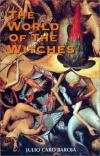 |

|
 |
buber.net > Basque > Features > Books > Book Review: The World of the Witches by Julio Caro Baroja
For security reasons, user contributed notes have been disabled.
Book Review: The World of the Witches by Julio Caro Baroja
by Blas Pedro Uberuaga June 28, 2003
Read: January, 2002.
 This book discusses the details of witchcraft as it has been
manifested in Europe since the time of ancient Greece. Though Baroja
doesn't give many details about what the nature of witchcraft was at
that time, as he progresses through the history of Europe, and has
access to more documents, the picture he paints becomes more and more
elaborate. This book discusses the details of witchcraft as it has been
manifested in Europe since the time of ancient Greece. Though Baroja
doesn't give many details about what the nature of witchcraft was at
that time, as he progresses through the history of Europe, and has
access to more documents, the picture he paints becomes more and more
elaborate.
His description of witchcraft in Greece draws mainly from the plays
and histories written by Greeks of that time. Thus, Medea and witches
much like her make up his picture of witches at that time. It is a
confusing picture, as one is never clear if this is what the Greeks
truly believed about witches or if this was just the poetic license
used by authors of the time. However, when one recalls the way the
Greeks viewed the religious, with gods and goddesses interacting with
people all of the time, maybe these depictions of witches in the plays
are not very far off from what the Greeks believed.
As history progresses, we gain more information about at least what
certain groups of people believed regarding witchcraft.
Unfortunately, these views are mostly of those prosecuting supposed
witches, not the witches themselves. Baroja follows the development
of their views, from seeing witchcraft as an annoying belief, maybe
with some roots in reality, to the complete identification of its
practice with Satanism. By the time of the Inquisition and similar
prosecutions occuring in Protestant countries, witches were viewed as
subjects of the devil, performing the most vile acts in his name.
At all times, there seem to have been some people more level headed
that recognized witchcraft might be the result of hysteria or drug
induced halucinations. But these people were rare and it wasn't until
much later, at the times of the Reformation, that these views became
the majority.
Baroja describes in some detail the phenomena of witchcraft in the
Basque Country. The reason for his emphasis on this region is
twofold: that is where he is from, but also because witches from that
region had gained some noteriety. He follows some of the important
trials, points out that the Inquisition was generally not very quick
to judge witches, and illustrates the evolution of beliefs about
witchcraft, with Goya being the pinacle of disbelief in its belief.
This makes a good companion to The Witch's Advocate by Gustav
Henningsen which follows in more detail some of the trials. This
gives a broader introduction to the field. Baroja also discusses some
of the other theories of his time, such as the practice of witchcraft
being the direct inheritor of pagan worship practices. He seems to
doubt most of these theories. It is hard to know if he believes that
covens really occured or if they were mostly drug induced dreams. He
seems to lean toward the later, though it isn't clear.
This book is definitely not the most captivating, as the writing is
sometimes a bit dry, but for anyone interested in the history of
witchcraft, especially in the Basque Country, it does make for an
interesting read.
This page is part of Buber's Basque Page and is maintained by Blas Uberuaga.
Please report any problems or suggestions to Blas.
Eskerrik asko!
|
|
 |







 This book discusses the details of witchcraft as it has been
manifested in Europe since the time of ancient Greece. Though Baroja
doesn't give many details about what the nature of witchcraft was at
that time, as he progresses through the history of Europe, and has
access to more documents, the picture he paints becomes more and more
elaborate.
This book discusses the details of witchcraft as it has been
manifested in Europe since the time of ancient Greece. Though Baroja
doesn't give many details about what the nature of witchcraft was at
that time, as he progresses through the history of Europe, and has
access to more documents, the picture he paints becomes more and more
elaborate.





